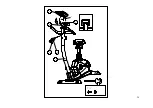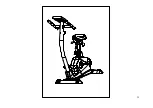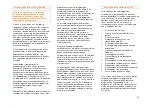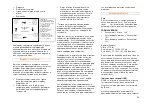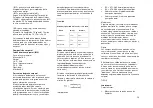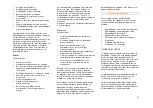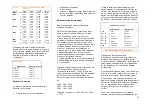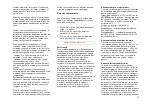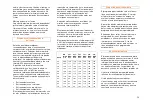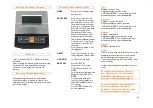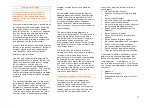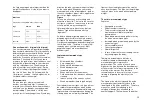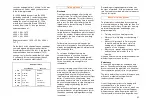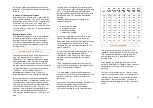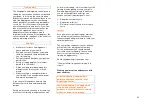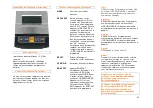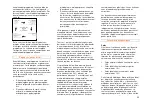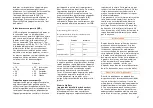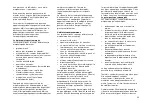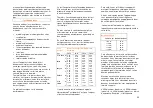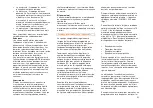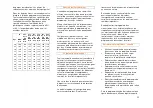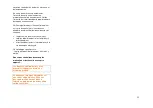
38
Regularly check your progress, so you can
adapt your training program if necessary. The
following survey shows the interaction between
the 4 elements, which are important in an
efficient training program.
Diagnostic – initial level
Before setting up a program, you have to take
note of some parameters and take your sizes.
These measurements will help you determine
your present physical condition . It is the
intention to collect all data concerning your
personality, your health and your
performances.
•
Individual data : age, sex, figure, weight,
fat percentage, measurements, pictures,
etc.
•
Data concerning your health : blood
pressure, orthopedic data, research of the
metabolism, serious diseases, injuries, etc.
•
Performance data : endurance tests,
power tests, movement tests and speed
control is often not necessary in fitness.
Coordination of the movements however is
crucial because it is very important when
you execute the exercises.
“Clumsiness” usually means a lack of exercise.
Therefore stick to the preset modules when
you exercise , even if it is an endurance sport.
Every test, intellectually or physically, shows
you your personal possibilities at a certain
moment in time. Even though mathematic
results become inadequate after a certain time,
the results which you will achieve (after the
same test one week later) will be better than
the first one, because you have been able to
locate your weak points and adapt your
training in order to get rid of your
shortcomings.
We work in the same way for the body. Let us
assume you have taken an endurance test and
the result of this test is 20% under the average
level. This result must now help you to set up a
program to achieve this average level. This
shows that the test is the base to set up a
training program in order to reach your goal.
So it is very important you check your
performances on a regular base to see if they
measure up to the preset goals. If not, you
have to adapt your training program.
The results of these check-ups give you the
opportunity to compare your performances
with the average performances, but also show
if you are making progress. After 6 weeks we
begin again with the same test to check if your
performances have been improved and how
much they have been improved.
Physical features
Weight
Are you happy with your body, often depends
on the balance. But what is the ideal weight ?
Following formulas are known to determine the
ideal weight:
•
Normal weight = girth waist in centimeter –
100
•
Ideal weight women = normal weight –
15%
•
Ideal weight men = normal weight -10%
This formula designed by “Broca” has a limited
value. As long as there is no new method to
determine the ideal weight, the image we have
of ourselves, tells us more than any other
number. But a lot of people feel better when
they can compare themselves with figures and
numbers. Therefore it is sensible to take into
account a few well known formulas as the
body mass index (BMI) and with some reserve,
the
waist to hip rate
(girth waist – hip).
Body Mass Index (BMI)
The BMI refers to the connection between
weight and body shapes, which allows us to
set up a better and exact standard than the
“Broca” formula.
BMI = present weight (in kg) : height in m².
Ex. A man of 70 kg and 1.70 m high has a
BMI of 70:1.7m² = 24.22.
In the table beneath you can situate yourself.
These values are a guidance and are not
guaranteed, especially not for sick persons,
children and elderly people.
Women
Men
--------------------------------------------------------------
< 19
<20
Underweight
19 – 24
19 – 25 Normal
> 24
> 25
Overweight
> 30
> 30
Corpulent
> 40
> 40
Obese
Fatpercentage
Body fat expressed in percentage tells us more
than numbers about the relation weight/waist.
To determine the fat percentage we have to
take into account some parameters depending
on age. You can determine your fat
percentage in different ways. You even find
many balances who also can measure your fat
percentage. If you want to lose weight, then
1. Diagnoqtique
entretien
préliminaire
et évaluation
Du niveau
2. Détermination des
objectifs et
des pronostics
Fixer le but à atteindre et
établir un plan
chronologique réaliste
3. Organisation
Prévoir des entraînements
à long, moyen et
court terme.
4. Contrôle
Vérification des résultats
obtenus en contrôlant
l’efficacité de
l’entraînement
au moyen de tests répétés
Programmation
Optimale
de
L’entraînement
Summary of Contents for M-430
Page 1: ...1...
Page 2: ...2...
Page 7: ...7 DKN DKN 2 DKN DKN DKN...
Page 15: ...15 DKN 140 300 1 2...
Page 16: ...16...
Page 17: ...17...
Page 18: ...18...
Page 19: ...19...
Page 20: ...20...
Page 21: ...21...
Page 22: ...22...
Page 23: ...23...
Page 24: ...24...
Page 25: ...25...
Page 26: ...26...
Page 89: ...89 5 35...
Page 92: ...92 80 90 12...
Page 94: ...94 4 6 1 3 5 6 12 400 220 70 85 60 70...
Page 98: ...98...
Page 99: ...99...
Page 100: ...100...

